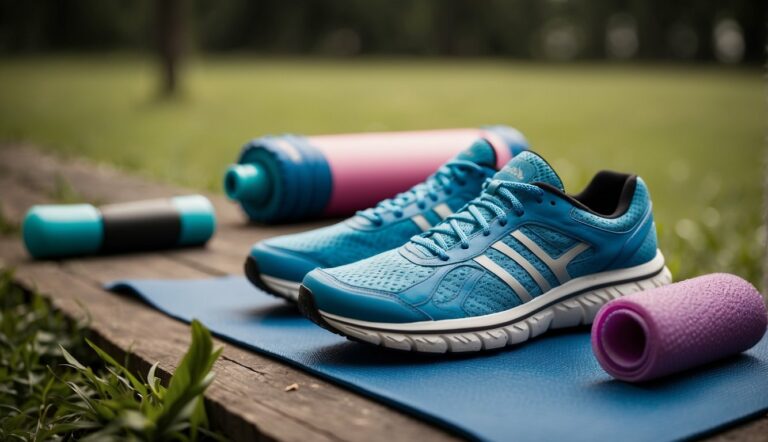Running Warm Up for IT Band: Key Routine, Stretches, and Exercises
Warming up before a run is crucial for protecting your IT band – the ligament that runs down the outside of the thigh from the hip to the shin. IT band syndrome is a common injury among runners that can derail your training and overall health.
To prevent such injuries, integrating a focused warm-up routine can enhance the flexibility and strength of your IT band and associated muscles.
Your warm-up should start with dynamic stretching to increase blood flow and prepare your muscles for the exercise ahead. Activities like leg swings, hip circles, and walking lunges target the hip region and can help reduce the stiffness of the IT band, thus preparing your body for the impact of running.
This approach not only primes your body for a workout but can also bolster injury prevention, ensuring you maintain your running schedule without unneeded interruptions.
While stretching is beneficial, incorporating strengthening exercises into your warm-up can further safeguard your IT band. Exercises utilizing mini bands or stability tools emphasize muscle engagement and activation around the hip and thigh, fortifying the areas around the IT band. Building a strong foundation around this ligament is key to avoiding the irritation that often leads to pain and inflammation, making these exercises a must-do before hitting the pavement.
Best Pre-Run Warm-Up Routine for IT Band Syndrome
If you’re dealing with IT Band Syndrome, it’s crucial to perform a warm-up routine that carefully prepares your hips, thighs, and IT band for the activity to come. Here’s a step-by-step warm-up routine tailored for this condition:
1. Foam Rolling (5 minutes)
- Focus on the outer thigh (IT band), quadriceps, hamstrings, and glutes.
- Spend about 30-60 seconds on each muscle group, rolling slowly and pausing on tender spots.
2. Walking (2 minutes)
- Start with a gentle walk to gradually increase your heart rate and circulation.
3. Side Leg Raises (2 minutes)
- Lie on your side with legs straight.
- Raise the top leg up to about 45 degrees and then lower it back down.
- Perform 10-15 reps on each side.
4. Hip Circles (2 minutes)
- Stand and lift one knee to hip level.
- Rotate the knee outward to make a circular motion, then reverse the direction.
- Do 10 circles each way per leg.
5. Walking Lunges (3 minutes)
- Step forward into a lunge position, keeping your knee aligned with your ankle.
- Push back to the starting position and alternate legs.
- Do 10-15 lunges on each leg, focusing on proper form.
6. Glute Bridges (2 minutes)
- Lie on your back with knees bent and feet flat on the ground.
- Lift your hips to create a straight line from knees to shoulders.
- Hold for a few seconds, then lower back down.
- Perform 10-15 reps.
7. IT Band Stretch (2 minutes)
- Cross one leg over the other while standing and lean to the opposite side until you feel a stretch along the outer thigh.
- Hold for 30 seconds, then switch sides.
8. Dynamic Leg Swings (2 minutes)
- Hold onto a stable object for balance.
- Swing one leg forward and backward, then side to side, keeping the movement controlled.
- Perform 10-15 swings in each direction on each leg.
Total Time: ~20 minutes
Remember, the key is to perform these exercises with a focus on gentle, controlled movements to avoid further irritation of the IT band. It’s also important to listen to your body—if any exercise exacerbates your symptoms, you should stop and consult a healthcare professional.
After your run, cool down with gentle stretching and consider applying ice to the affected area if needed. Regular strengthening and stretching exercises targeting the hips and glutes can also help prevent IT Band Syndrome from recurring.
| Warm-Up Exercise | Target Muscles | Duration/Reps |
|---|---|---|
| Foam Rolling | IT band, quadriceps, hamstrings, glutes | 5 minutes total (30-60 seconds per muscle group) |
| Walking | General lower body | 2 minutes |
| Side Leg Raises | Hip abductors, IT band | 10-15 reps per side |
| Hip Circles | Hip flexors, glutes | 10 circles each way per leg |
| Walking Lunges | Quadriceps, hamstrings, glutes, hip flexors | 10-15 lunges per leg |
| Glute Bridges | Glutes, hamstrings, lower back | 10-15 reps |
| IT Band Stretch | IT band, TFL, glutes | 30 seconds per side |
| Dynamic Leg Swings | Hip flexors, hamstrings, adductors, abductors | 10-15 swings per direction per leg |
Complete these steps for an effective pre-run routine that primes your body for the demands of running, helping to safeguard against the aggravation of IT Band Syndrome.
Dynamic Stretching for IT Band Syndrome
Dynamic stretching can be an effective component of your warm-up routine to address symptoms associated with Iliotibial Band Syndrome (ITBS). Incorporating movement-based stretches aids in increasing blood flow, improving flexibility, and preparing your muscles for the demands of running.
Leg Swings
- Frontal Plane: Stand sideways near a wall for balance. Swing your outside leg forward and backward, gradually increasing the height of each swing.
- Sagittal Plane: Face the wall, using it for support. Swing each leg side to side, crossing in front of your standing leg.
Walking Lunge with a Twist
- Step forward into a lunge position.
- As you lower into the lunge, engage your core and rotate your upper body toward the front knee.
- Return to standing and repeat on the opposite side.

Ensure each stretch is controlled and within a comfortable range of motion. Perform each dynamic stretch for approximately 30 seconds to 1 minute before running. These activities are not only helpful in managing IT band discomfort but also beneficial in overall injury prevention.
For more guidance on managing ITBS with a multifaceted approach, the following resources provide detailed insights: managing iliotibial band syndrome with a multifaceted approach and treatment of distal iliotibial band syndrome in a long distance runner with gait re‐training emphasizing step rate manipulation.
By integrating dynamic stretches specifically designed for IT band syndrome into your pre-run routine, you set yourself up for a healthier and more enjoyable running experience.
Muscle Activation for IT Band Syndrome
When dealing with IT Band Syndrome, specifically targeting muscle groups related to the IT band is key. Your focus should be on the hip abductors, particularly the gluteus medius. Studies suggest that these muscles play a crucial role in stabilizing the hip during running.
Warm-Up Exercises:
- Side Leg Raises: Lie on your side with your legs stacked. Lift the top leg while keeping it straight, then lower it with control. Aim for 2 sets of 15-20 repetitions on each side.
- Clamshells: Still on your side, bend your knees at a 90-degree angle. Keeping your feet together, open and close your knees like a clamshell. Perform 2 sets of 15-20 repetitions on each side.
Key Points:
- Focus on form and control; quality over quantity.
- Use a resistance band around your thighs to increase the challenge if too easy without it.

Here are some additional resources for exercises that aim to support the IT band through hip muscle strengthening:
- For understanding the relationship between iliotibial band syndrome and hip neuromechanics, visit ScienceDirect.
- To explore treatment options that include gait re-training, refer to this article on PubMed Central.
Ensuring proper muscle activation with these exercises can be a critical part in the management of IT Band Syndrome. Remember, incorporate these movements into your regular warm-up routine to help prevent IT band-related issues.
What Is IT Band Syndrome?
Iliotibial Band Syndrome (ITBS) is one of the most common causes of knee pain in runners, stemming from overuse and poor running form. Let’s break down the anatomy of this important structure and identify what typically causes its irritation.
Anatomy of the IT Band
The iliotibial band (IT Band) is a thick, fibrous band of tissue that runs from your hip to your knee. It works with hip muscles, including the Tensor Fascia Lata (TFL), to stabilize the hip and knee during activities like running. Its position and function make it highly susceptible to overuse injuries, particularly in distance runners.
Common Causes and Symptoms
IT Band Syndrome is commonly caused by repetitive friction where the IT band crosses over the knee joint, combined with inflammation from overuse. Symptoms typically include:
- Pain: Often on the outside of the knee, which may radiate up the thigh.
- Hip discomfort: Due to TFL involvement.
- Swelling: Around the knee or along the band itself.
Running form plays a crucial role. Overpronation, weak hip muscles, and running on uneven surfaces can stress the IT band. If you’re experiencing symptoms, consider your running mechanics and muscle strength, especially in the hip area, to mitigate ITBS.
Injury Prevention and Recovery
Injury prevention and recovery for IT band syndrome is crucial for runners. Incorporating foam rolling, specific strengthening exercises, and effective post-run recovery strategies can help maintain muscle balance and mobility.
Foam Rolling Techniques
Foam rolling can alleviate tension around the IT band by targeting the tight tissues that contribute to discomfort. For the IT band:
- Place the foam roller on the ground.
- Lie on your side with the foam roller under your hip.
- Slowly roll down from the hip to just above your knee.
- Spend extra time on tender areas, rolling back and forth.
Strengthening Exercises
To prevent injuries and enhance fitness, focus on exercises that strengthen the hips and core. Effective exercises include:
- Glute Bridge:
- Lie on your back with knees bent and feet flat on the floor.
- Lift your hips to form a straight line from your knees to shoulders.
- Hold for a few seconds, then lower.
- Clamshells with Resistance Band:
- Loop a resistance band just above your knees.
- Lie on your side with knees bent at a 90-degree angle.
- Keeping your feet together, raise the top knee and hold.
- Lower slowly and repeat.
Post-Run Recovery
Recovery is as important as the run itself. Post-run, prioritize rest and mobility to avoid overuse injuries. Key Recovery Tips:
- Stretch: Focus on flexibility with stretches that target the hips and legs.
- Rest: Ensure you have sufficient rest days to allow for muscle recovery.
- Mobility Work: Engage in light activities on rest days, such as walking or swimming, to maintain mobility.
By adhering to these measures, you can sustain a healthy balance between running and recovery, minimizing the risk of IT band-related injuries.
Incorporating Healthy Practices
To maintain your health and prevent injuries during running, focusing on nutrition, hydration, and cross-training is essential. These practices foster balance and can complement your running routine.
Nutrition and Hydration
Nutrition: Prioritize a balanced diet including carbohydrates for energy, proteins for muscle repair, and healthy fats for sustained performance. Before running, consuming a meal rich in carbohydrates can fuel your muscles, and including lean protein aids recovery post workout. Remember, individual needs may vary.
Hydration: Adequate water intake is crucial for runners. Aim to drink at least 500ml of water two hours before your run to ensure you’re well-hydrated. Then, during running, continue to sip small amounts to replace fluids lost through sweat.
Cross-Training Benefits
Cycling: It provides a low-impact cardiovascular workout that helps maintain fitness while reducing the strain on your IT band and knees. Incorporating cycling one to two times a week can enhance your running performance and contribute to overall muscle balance.
Swimming: Swimming and pool running offer non-weight-bearing exercise options that alleviate stress on the body and particularly benefit the IT band. They can also improve cardiovascular health without the impact of running, promoting injury prevention.
Yoga: Regular yoga practice encourages flexibility, core strength, and balance—all beneficial for runners. Incorporating yoga stretches specifically targeting the IT band can help in keeping you injury-free.






